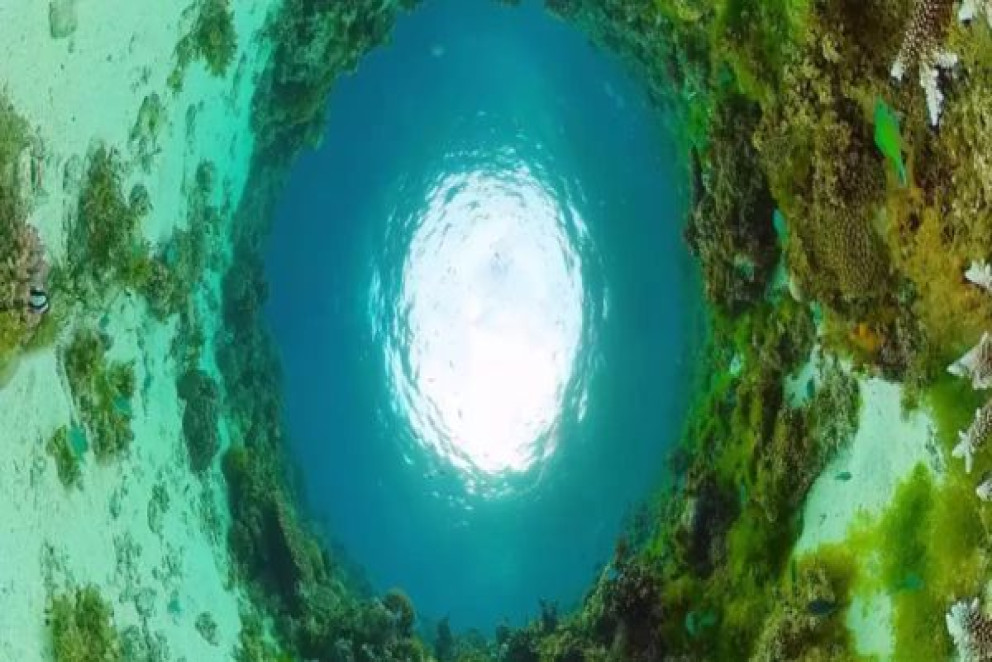Blog Details

World’s deepest blue hole discovered, with hidden tunnels and caves!
If reports are to go by, researchers may have chanced upon Earth's deepest blue hole—an enigmatic underwater sinkhole whose depths seem to appear bottomless!
Recently published in Frontiers in Marine Science, a study unveils the staggering dimensions of the Taam Ja' Blue Hole, nestled within Mexico's Chetumal Bay. Fresh measurements from a December diving expedition reveal its unfathomable descent to a depth of 1,380 ft, nearly rivalling the height of the iconic Trump Tower in Chicago! Such profound depths hint at the possibility of undiscovered marine life thriving within this abyss, awaiting exploration.
This newfound blue hole, plunging 1,380 ft deep, eclipses its predecessor, the Sansha Yongle Blue Hole (also known as the Dragon Hole) in the South China Sea, by an impressive 480 ft, as per the reports.
These submerged abysses stand as geological wonders. Crafted by glacial runoff, blue holes (scientifically termed Karst formations) are essentially submerged vertical caves, sprawling hundreds of feet downward and sideways, creating unbelievable sapphire sinkholes.
Yet, delving into these depths poses challenges. The absence of oxygen and the presence of hazardous hydrogen sulphide gas demand specialised gear and expertise for exploration. Such restricted access turns it into a mystery, waiting to be uncovered for future scientific inquiry.
Despite being discovered in 2021, initial depth readings using echo-sounders only reached 900 ft, failing to unveil the complete picture. A subsequent dive equipped with advanced tools shed further light. The expedition, aimed at studying the environment of Taam Ja' Blue Hole, utilised a state-of-the-art CTD (conductivity, temperature, and depth) profiler. This cutting-edge device, tethered to a 1,640-foot cable, transmits real-time water data to the surface.
However, even with this sophisticated apparatus, researchers couldn't reach the bottom. The cable halted at 1,380 ft, possibly encountering an underwater ledge or strong currents. Their quest to definitively reach the abyss's nadir persists!
Scientists speculate that the bottom may house a labyrinthine network of caves and passages, potentially interconnected. This concealed realm could harbour unseen life forms, flourishing in the darkness.
The ramifications are staggering. Some suggest that Taam Ja' Blue Hole might act as an underwater analog of a black hole, serving as a gateway to concealed ecosystems, perhaps spanning vast epochs.
This conjecture isn't entirely far-fetched. In 2012, scientists exploring blue holes in the Bahamas unearthed unique bacteria thriving in total darkness. This revelation implies that extreme environments might shelter life forms adapted to survive in unimaginable ways, offering unbelievable glimpses into extraterrestrial life.
Recently published in Frontiers in Marine Science, a study unveils the staggering dimensions of the Taam Ja' Blue Hole, nestled within Mexico's Chetumal Bay. Fresh measurements from a December diving expedition reveal its unfathomable descent to a depth of 1,380 ft, nearly rivalling the height of the iconic Trump Tower in Chicago! Such profound depths hint at the possibility of undiscovered marine life thriving within this abyss, awaiting exploration.
This newfound blue hole, plunging 1,380 ft deep, eclipses its predecessor, the Sansha Yongle Blue Hole (also known as the Dragon Hole) in the South China Sea, by an impressive 480 ft, as per the reports.
These submerged abysses stand as geological wonders. Crafted by glacial runoff, blue holes (scientifically termed Karst formations) are essentially submerged vertical caves, sprawling hundreds of feet downward and sideways, creating unbelievable sapphire sinkholes.
Yet, delving into these depths poses challenges. The absence of oxygen and the presence of hazardous hydrogen sulphide gas demand specialised gear and expertise for exploration. Such restricted access turns it into a mystery, waiting to be uncovered for future scientific inquiry.
Despite being discovered in 2021, initial depth readings using echo-sounders only reached 900 ft, failing to unveil the complete picture. A subsequent dive equipped with advanced tools shed further light. The expedition, aimed at studying the environment of Taam Ja' Blue Hole, utilised a state-of-the-art CTD (conductivity, temperature, and depth) profiler. This cutting-edge device, tethered to a 1,640-foot cable, transmits real-time water data to the surface.
However, even with this sophisticated apparatus, researchers couldn't reach the bottom. The cable halted at 1,380 ft, possibly encountering an underwater ledge or strong currents. Their quest to definitively reach the abyss's nadir persists!
Scientists speculate that the bottom may house a labyrinthine network of caves and passages, potentially interconnected. This concealed realm could harbour unseen life forms, flourishing in the darkness.
The ramifications are staggering. Some suggest that Taam Ja' Blue Hole might act as an underwater analog of a black hole, serving as a gateway to concealed ecosystems, perhaps spanning vast epochs.
This conjecture isn't entirely far-fetched. In 2012, scientists exploring blue holes in the Bahamas unearthed unique bacteria thriving in total darkness. This revelation implies that extreme environments might shelter life forms adapted to survive in unimaginable ways, offering unbelievable glimpses into extraterrestrial life.
Source: Times of India



